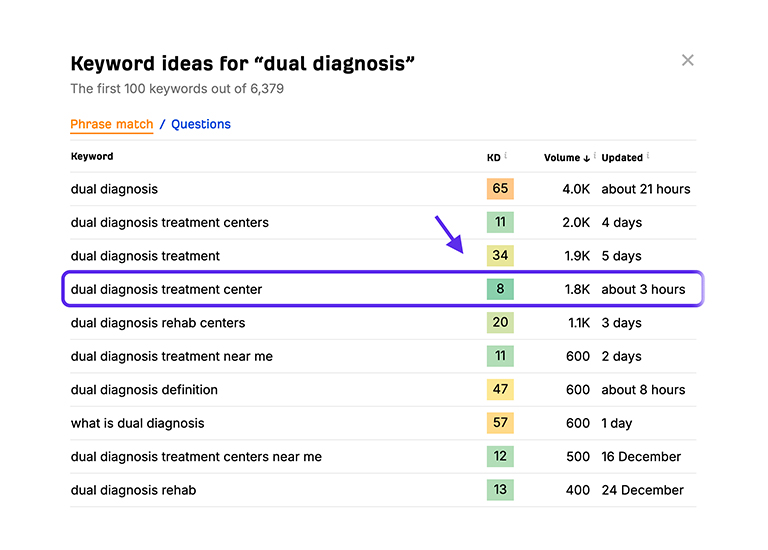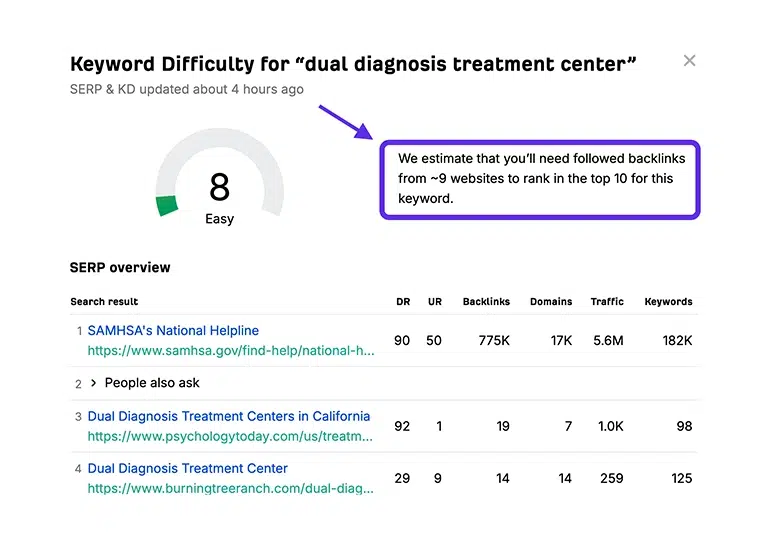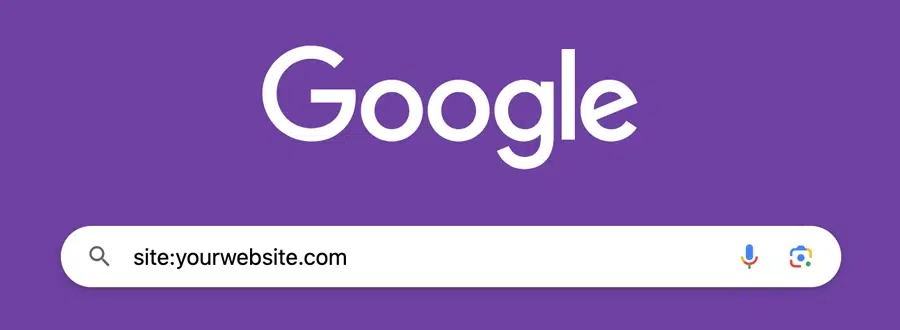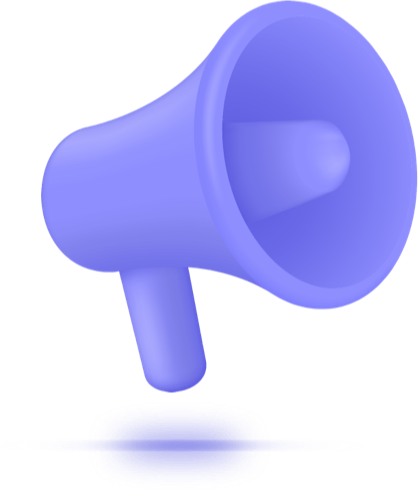In this article we will guide you in strategically choosing a content topic by focusing on a specific long-tail keyword that has a higher likelihood of achieving a favorable position in Google search results.
By selecting the appropriate keyword as the foundation for your new content, you can significantly boost your chances of ranking higher, ensuring greater visibility in search and connecting with potential clients precisely when they are seeking your services.
By the end of the article you will learn:
- How to identify good keywords to target
- The importance of keyword difficulty (KD) and how to identify it
- How to identify your domain authority (DA) vs. your competitors and why it matters
- The main categories of on-page optimization
- Tools and resources to develop your new content
- Do's and dont's of promoting your new content
The First Steps Of Drug Rehab SEO
Before we begin, it is important to note that SEO necessitates consistent commitment and continuous effort. However, once you attain desired rankings for a particular group of keywords, your position can remain relatively steady for a significant period of time.
The first thing you need to do is answer these questions:
- What is your best service?
- What keyword should you target?
- How hard is it to rank for this keyword?
- How do I optimize my content?
You might be thinking, “I’ve got the answer to the first question, but how on earth can I determine which keyword to target or how hard it will be?”
Let’s break this down a bit:
Keyword research for a drug rehab SEO strategy
So, you’ve identified your most valuable service – let’s say it’s “dual diagnosis.”
Now, the next step is to pinpoint the most optimal keyword variation to target. Fortunately, there are free tools that can kickstart this process.
Head over to ahrefs free generator tool. Once there, enter “dual diagnosis” and click “find keywords.” Pay attention to the columns labeled “KD” (keyword difficulty) and “Volume.”
The score out of 100 is used to determine Keyword Difficulty (KD), indicating how challenging it might be to rank in search engines for a specific keyword. In simple terms, the lower the number, the easier it is to rank. KD is often based on the number of backlinks a page may need to rank for that keyword.
Here, the goal is to select a keyword with low difficulty and high volume. For instance, in this example, “dual diagnosis treatment center” fits the criteria with only an 8 KD and almost 2K in traffic volume. So, this will become the keyword you want to optimize for in your content.
Understanding Keyword Difficulty When Doing SEO for Addiction Treatment
Okay, as mentioned earlier, keyword difficulty (KD) is primarily determined by the number of backlinks required to secure a top 10 ranking.
To determine the specific number of backlinks needed for our chosen keyword, visit ahrefs.com’s keyword difficulty tool. Enter the keyword – in our case, “dual diagnosis treatment center” – and proceed to click on “check keyword.”
This free tool will estimate the number of backlinks required for a top-10 ranking with the specified keyword. However, keep in mind that SEO involves numerous metrics, but these are excellent starting points.
Now, you might be wondering, “How do I acquire those nine backlinks?” We’ll delve into some ideas later in the article. But first, now that we have a viable keyword and some backlink information about it, let’s take a look at our competitors and ensure we can compete with them for this keyword.
Domain Authority for Drug Rehab SEO
Before creating your content, it’s essential to assess your competitors’ performance for the targeted keyword. First, compare the domain authority of your competitors to your own.
If you’re unfamiliar with domain authority (DA), it’s another metric used to measure website credibility. It evaluates the quality and quantity of backlinks pointing to a site, assigning a score out of 100. Generally, higher scores indicate greater authority in the eyes of search engines.
Moz offers a free tool to check domain authority. If you use Google Chrome, you can download their browser extension, and it will display the domain authority of all the websites on the SERP page. Otherwise, you can use their website to check individual domain ratings.
For this example, we will use the browser extension.
Now, head over to Google and type in “dual diagnosis treatment center” and click enter. Your screen should now look similar to the image below. On the bottom of each competitor site you will see their DA listed.
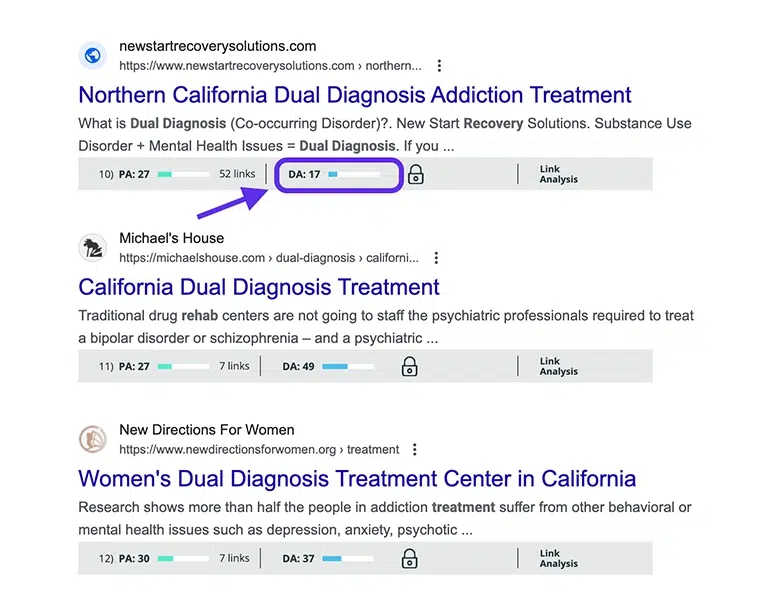
Now, enter “site:www.yourwebsite.com” into the Google search bar and press enter. You should now see your website in the top search result along with the associated DA score, like in the competitors example above.
Assess your Domain Authority (DA) in comparison to your competitors. If you find that you’re in close proximity, that’s fantastic, and you can proceed to plan your content strategy. However, remember that all these metrics matter, but quality content can often outperform those with slightly higher metrics.
To begin, start by opening your competitors’ pages and analyzing their content. Identify consistent topics and pinpoint areas where information might be lacking. Then, develop an outline for how you intend to deliver more valuable content.
On-page Optimization and Content Creation for a Drug Rehab
Many of the individuals reading your content are likely in challenging circumstances, either grappling with addiction personally or supporting a family member or loved one facing addiction. Consequently, it’s crucial to employ compassionate language and offer practical, valuable information.
Assuming you already have a blog on your website, there are several options available for developing content.
Firstly, you can write the article yourself or use a voice-to-text translator to type for you. Some people find this easier and quicker than typing out their ideas.
You could also hire and collaborate with a freelance copywriter or hire an agency to perform content marketing for you. Whatever route you choose, remember that even great content still needs to be optimized for SEO.
Let’s look at some major factors for optimizing your new content.
It’s a lot, so buckle up. Each one of these deserves its own article, but we have summarized each topic to get you more familiar with each category.
On-page SEO categories
This is the page title shown on the SERP pages, include your targeted keyword.
This is the description that can show up on the SERP page results. The description should include your targeted keyword.
These are HTML tags that wrap around your content title and subheadings. They should flow in sequential order from H1 to H6. You will want to include your keyword in the H1 tag and variations of your keyword in the subheading H2 tags.
URL structure is the hyperlink that will be the web address to your new content. You should always aim to keep your content organized with relevant subfolders. Your URL should also contain your target keyword. (i.e www.yoursite.com/services/dual-diagnosis-treatment-center)
You will want to use the keyword and variations of the keyword in your content as well. But DON’T overuse it. You can be punished for “keyword stuffing”. Quality over quantity is the best rule here.
Always use original content. Use Grammarly to check for plagiarism and grammatical errors. Also, use transitional words and be clear and concise.
Any images you upload to your site should be compressed to under 100KB, and for best results, use the .webp extension. Free tools like tiny.png and cloudconvert.com can assist in optimizing images and converting file formats.
Within your content, you will want to find ways to link to other relevant pages on your site.
Link out to other websites, just ensure they are reputable sites like government agencies. (i.e https://www.cdc.gov/ – https://www.ncbi.nlm.nih.gov/)
Use Google’s Page Speed Insights to see how well your page performs. If your site is not performing well, you may need to hire an agency to assist with fixes.
Make sure to implement good “call to actions” throughout your content. These can be buttons that link to your contact form.
To stay relevant and continue to boost your rankings, you will need to update or refresh your content every so often. Don’t just set it and forget it.
Drug Rehab SEO: Off-Site Link Building
Not all links are created equal. Furthermore, when seeking backlinks for your content, it’s crucial to ensure that the websites are reputable and not associated with dubious or malicious activities.
Link building demands considerable time and effort; thus, it’s essential to exercise patience.
Persevering through the process is worthwhile. Moreover, acquiring high-quality backlinks brings long-term benefits. Opting for shady alternatives may lead to penalties and exclusion from search engine results, a risk not worth taking.
Do's and Don'ts of backlinking
- Get naturally acquired backlinks.
- List on reputable directories.
- Perform outreach to local media outlets
- Share your articles on social media
- Reach out to non-competitor websites in the drug rehab sphere and ask to write a guest blog post
- Look for quality websites with broken links and offer to replace their broken link with your new content link. Use ahrefs.com’s free tool to find broken links
- Join and write for related forums
- Use your credentialing to offer citations as well as connect with journalist
- Send spammy emails
- Purchase low-quality backlinks
- Write for Published Blog Networks (PBN)
- Don’t be impatient, off-page SEO takes time
Why SEO for Addiction Treatment Matters
- 27% increase in the number of treatment facilities in the U.S since 2003(1)
In the digital age, online searches significantly influence the decision-making process. Moreover, it’s not just beneficial, but crucial to have a well-optimized online presence. A robust SEO strategy increases the likelihood of connecting with individuals seeking assistance. Additionally, it makes a meaningful impact on their lives, positioning your rehab facility as a prominent leader in the industry.
If you’re tired of marketing your treatment center alone or just fed up with failed SEO agencies who don’t provide attention to detail or understanding of the treatment industry, give us a shout. We’d be happy to take a look at your website, learn more about your treatment center, and employ our proven growth strategies.

